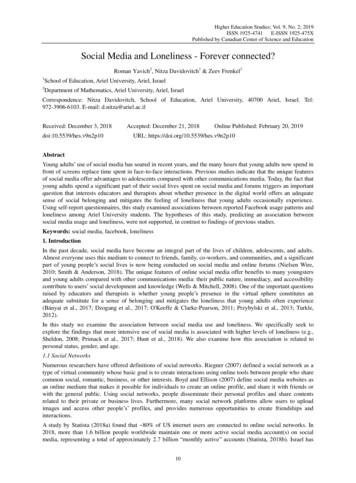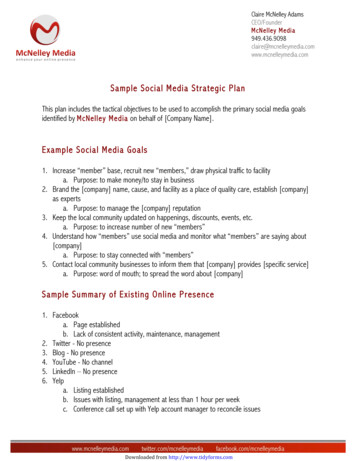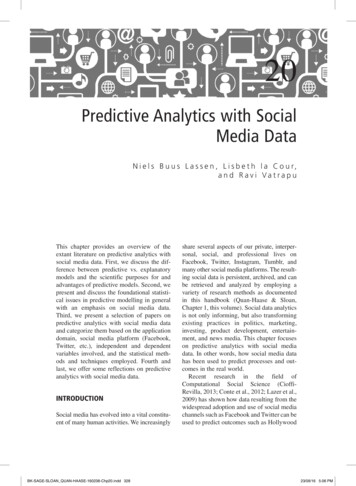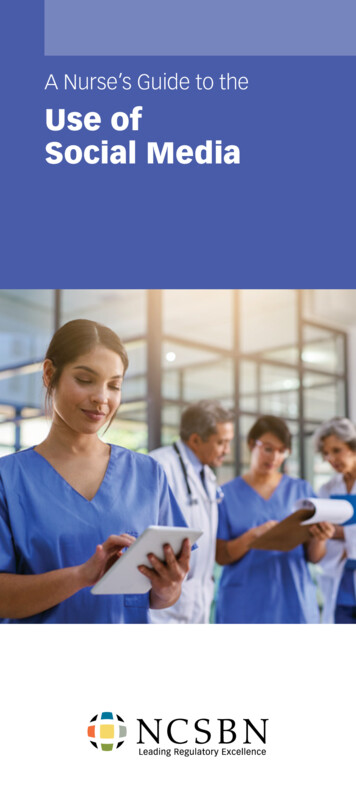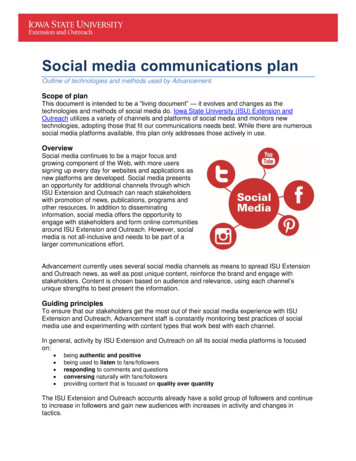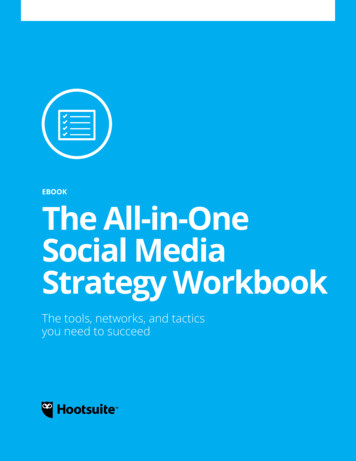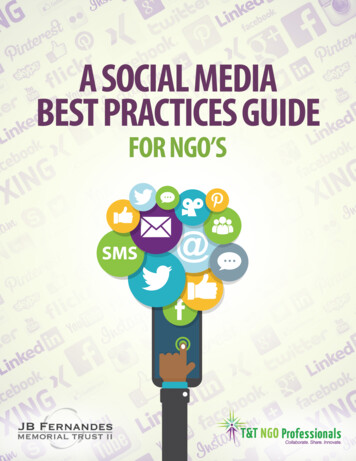
Transcription
A SOCIAL MEDIABEST PRACTICES GUIDEFOR NGO’S
WHAT ISSOCIAL MEDIA?TheTOP 8reasons whyNon-profits shoulduse Social Media asa marketing tool:Social Media is a way for people tocommunicate and interact online.It's called Social Media because usersengage with (and around) it in asocial context, which can includecreating online communities to shareinformation,ideas,personalmessages, and other interactivecontent (such as videos).Over the last several years, there hasbeen an explosion of growth inpopular Social Media platforms likeFacebook, Twitter, LinkedIn, YouTube,Instagram, Google , Pinterest, andmany others. It's safe to say that theera of Social Media is just gettingstarted, and the need for Social Mediawill only become stronger over time.1 To educate the public about yourcause or mission cost effectivelyand instantly2 To build a community of supporters3 To find and engage influencersto help spread your message4 To share news, events and projects5 To raise funds6 To recruit volunteers7 For donor recognition8 For employee recruitmentNon-profitorganisationshavebecome increasingly social over thepast decade as the benefits of socialmedia platforms have becomeundeniable, whether they arecultivating a dedicated Facebookcommunity or blazing on othernetworks such as Instagram. NGO’sshould take advantage of what SocialMedia has to offer.1
SETTING GOALSAs with most marketing tools, managing your SocialMedia must be strategic and goal oriented. Identifyingyour Non-profit’s reason for using Social Media will helpto pinpoint the goals and objectives needed to achievesuccess.Always keep your goals S.M.A.R.T.For example, if you intend to use Facebook to foster acommunity of supporters your goal may look like this: Toincrease the number of people interested in theorganization’s cause by gaining 1000 Facebook followersby December 31st 2017.IDENTIFYING YOURTARGET AUDIENCEThis step is fundamental to the creation of your SocialMedia strategy. Before you write a single post, it’simportant to know who you’re writing for. You mightbe tempted to think that your audience is the generalpublic. However, you need to understand your targetdemographic if you want to maximise your Social Mediastrategy and achieve your social media goals.In its simplest form demographics can be made up of:Gender- Male/Female e.g. Yes She Can, Single Fathers AssociationAge- Youth, Middle Age, Elderly e.g. Alzheimer's Association of T&T, T&T Youth AmbassadorsLifestyle- Diet and Exercise, Smokers etc. e.g. Diabetes Association of T&T, T&T Heath FoundationInterests- Animal lovers, eco/nature enthusiasts e.g. Animals Alive, Nature Seekers2
MAKE YOUR VOICE HEARD WITH THESE USEFUL TIPSUse a Conversational ToneOne of the keys to expressing your non-profit’svoice and tone on Social Media is by using aconversational tone. Make your audience feelconnected to your brand.Ensure your writers understand how to put yourbrand voice into actionIf your non-profit organisationwas a person, how would youdescribe its personality orcharacteristics?Developing your voice requiresyou to think how you want yournon-profit to be portrayed to thepublic.A consistent brand voice andvocabulary is essential toeffectively implementing yourSocial Media content strategies.Developing a healthy andunique brand personality createstrust over time. If your targetaudience can see a balance ofinformation,humourandeducation along with active usersubmissions, they’re more likely tointeract themselves.Be sure that anyone who creates content orcommunications for your organization knowsand understands your brand voice.Keep Your Voice ConsistentNothing confuses your audience more thaninconsistency. Maintaining your brand voicewill make your audience feel comfortablebecause that tone is consistent with the brandthey’ve grown to know. That familiarity andcomfort translate into high fan interaction andadvocacy over time.Revisit and Revise the Brand Voice as your NonProfit Changes over TimeAs your brand messaging evolves or the scopeof your non-profit changes it’s good to take alook at your brand voice and refresh it ifnecessary.3
CHOOSING THE BESTSOCIAL MEDIA PLATFORMSWhen it comes to choosing which Social Mediaplatform(s) your non-profit will utilise, select thosethat offer the best potential for reaching your idealaudience and broadcasting the type of mediayou've decided is best suited for your non-profit.You can't be amazing on every platform; that takesa huge amount of resources which non-profitsdon’t usually have at their disposal. Instead ofhaving a sub-par representation in a lot of places,be awesome on one or a few of them.The networks most popular amongnon-profits are Facebook, Twitter,Linkedin and for quality photo contentInstagram and quality video contentYoutube.How do you decide which platforms arebest for the needs of your non-profit?Ask yourself the following questions:Is your target audience on the network?Does the network fit your demographic?Do other non-profits have a presence here?Does it make sense for the content I intend to share?Does it make sense for me?Is it something you can easily fit into your life?Do you have time to manage it?After doing some research and observation, do you “get” how it works?4
TYPES OF CONTENTA SIMPLE 3 PART SYSTEM FOR NON-PROFITS ISTHE “THREE A’S” OF SHARING SOCIAL MEDIA CONTENT:Think about aspects of your non-profit thatcan be inherently social and create contentthat people will be excited to share!APPRECIATION1/3 of your social updates shouldrecognize your donors, supporters,volunteers, and employees.“Three A’s” of Sharing Social Media Content:From pictures and graphics to short videosand text, your non-profit should share avariety of posts across its networks. Visualcontent can often reach emotional triggersin a way that words alone cannot.It also is important to keep content fresh andeasy to consume. While every post doesn’tneed a link, social media can be a helpful toolfor directing people to your website, blog ormailing list.Globally, 74% of non-profits use social mediaas a megaphone to announce events andshare what they’re up to, instead of seekingout conversation. Moving away from /3 should engage and share informationrelevant to your non-profit’s mission,upcoming events, projects and activitiesto support this mission.APPEALS1/3 should solicit donations or help.5
SHARINGCONTENTThe below are variousways you can interactwith your audiencethrough yourcontent.Creating a Social MediaContent calendar willhelp you plan andschedule your socialmedia posts in advance.It allows you to plan forwhen your audience ismost likely to listen formaximum impact andengagement. Be sure tomake sure your contentis relevant, timely andkeptabreastwithcurrent trending topics.If you are working with ateam, or reaching out toothersinyourorganization for photosor information, a contentcalendar will help youstay on top of planningcampaigns and preparingmaterials in advance.Automating your contentpublishing also ensuresyour non-profit maintainspresence without tyingup resources.Determine a postingfrequency that will keepyour organization in frontof your audience whileleaving you time tomanage your community,sharenewsworthycontent and measureyour impact.6Check out the link for step by step instructionsfor scheduling posts on:Facebook: http://bit.ly/1hpJRM2Twitter: http://bit.ly/2lWRAdd2Aim to post 1-2 quality posts dailyon your social media platforms
yrotS ellingTA story that resonateswith your audienceinspires and sticks in away that other forms ofmarketing cannot. It isimportant therefore fornon-profitstounderstand and utilizethepowerofStorytelling.With a twist of creativity,every non-profit can usestorytelling to amplifytheirSocialMediamarketing efforts andcreate a meaningfulconnection with theirsupporters.Differentcommunication channelscan deliver stories in away that prompts readersto take action.Here are some amazingways you can implementstorytelling into yournon-profit's social mediaefforts:Use VisualsWith the average person’s attention span maxing out at 8 seconds, visualcommunication is a great way to tell a meaningful story in the form of aphoto album or collage. This can be used to hook supporters into your storyand prompt further action. Facebook would be the ideal location to deliversuch a story.Document a Work-in-ProgressYou don’t necessarily have to wait until your organization completes aproject to tell its story. The time between start and finish of your project is anopportunity to share real-time updates which creates a richer experience foryour followers and compels them to be more engaged with your work. Shorttweets and use of images and short video clips can broadcast your project asit unfolds!Share Their Story- Put a face to your causeTelling stories that revolve around specific individuals is one of the mosteffective ways to connect emotionally with your audience. Ask someonewho has benefitted from your non-profits’ cause to give a heartfelt tribute. Orask a board or staff member to share their own history with yourorganisation. What first activated him or her to become deeply engagedwith your mission? Why do they believe in your cause? A compellingexperience can touch supporters and challenge them to take action.Volunteer VoicesAs you document your event or project, turn the spotlight on yourparticipants and volunteers. Share their testimonials on your socialnetworks. Not only is it a great way to show gratitude for their support, but italso makes the support of a larger community more tangible to yourfollowers. This can be done across all Social Media networks and using richphoto or video media.7
ENGAGEMENTEngagement is all about connecting with your targetaudience in a meaningful way. For your non-profit thataudience can be made up of volunteers, beneficiaries,donors and employees. Engagement is critical to thesuccess of your Social Media strategy. Here are a few keypoints to ensure you hit the nail on the head.Identify Successful ContentThe first step to engaging your audience is identifyingthe types of content they respond to. Many Social Mediaplatforms have built in features which provides you withengagement metrics. This can come in the form ofanalytics and insights which can help you identify andmaximise on your best performing content.Invite ConversationPeople are much more likely to be engaged when askedquestions or inviting feedback. Whether you publishsurveys, seek advice, start a dialogue, or promote acompetition, motivate your audience to get involved.Respond to Messages and CommentsRespond to everyone who communicates with you onyour Social Media platforms in a timely manner of coursemaking use of your brand voice. The general rule iswithin a 24 hour period.Cross-Promote Your ContentDon’t be afraid to cross-promote your social mediacontent on other Social Media Channels. E.g. YourFacebook Posts can be tailored for Twitter and vici versa.Just like in the real world, buildingrelationships with people on SocialMedia takes time and requires along-term investment.8
MONITORING,MEASURINGAND EVALUATINGSOCIAL MEDIAWe’ve identified the importance of creatingconsistent quality content and boostingengagement and brand awareness. Now youwould want to monitor metrics that providevaluable insights into these facets.So what really happens after youpost, tweet, or share?Did you grab attention? Did you deliver delight?Did you cause people to want to share? Did youinitiate a discussion? Did you cause people totake an action? Did your participation delivereconomic value?Tracking performance and demonstratingresults will show the leaders of your non-profitthe importance of investing the time andresources into social media.You can use these simple metrics to measureSocial Media performance for your non-profit:Social Media ExposureAs you grow the followers on your Social Mediaplatforms grow, your influence gets a little wider,both in the number of people you will potentiallyreach and in the perceptions others have of you.For Facebook it’s your increased page likes,Twitter and LinkedIn your followers and YouTubeyour video views.EngagementEngagement is the sum of every interaction yourSocial Media platforms can receive includingcomments, shares, and reactions. Thisinformation tells you about the overalleffectiveness of your content. Did people likewhat you shared? Engagement is the validatorof social media success. Good engagementequals good sharing.Brand SentimentWhen it comes to social media, all publicity isn’tgood publicity. Negative consumer sentimentcan destroy your brand in a short time. Keep aneye on people’s comments and replies as well ashow they’re sharing your posts. Having a planfor how you’ll respond to negative responses isjust as important as avoiding it altogether.Google has a free tool called Google Alerts thatcan help you track brand mentions on the web.It’s important to track these metrics monthlyand compare them over time to gain insightson trends and make changes to your contentstrategy if need be.Click the links for information on using analyticsdata for your Facebook and Twitter pages:Facebook: analytics.facebook.comTwitter: analytics.twitter.com9
TO CONCLUDENo matter the size of your non-profit a well-executedsocial media strategy will effectively increaseawareness, engagement and retention for your brand.Social media is both an art and a science. Whatever phasein your social media marketing journey that you’re on,there’s no doubt it will be beneficial to learn the varioustips, tricks and tools discussed in this document.Over time, you will learn what content gets yourcommunity talking and how to fine tune yournon-profit’s Social Media strategy to get the bestpossible results.But most importantly, have fun doing it. Set reasonableexpectations and understand that building a sustainablesocial media strategy is a long-term game. Like any greatrelationship, it’s all about communication over time, andthere’s no better time than now to get started!10
SOCIAL MEDIA TIPS FOR SUCCESSBelow are some tips that will help you to maintain your focus so youwon’t forget any of the important steps!FACEBOOK TIPSTWITTER TIPSHumanise your posts- Thosewho connect with your posts ona deeply personal level will bemore likely to donate orvolunteer for your cause.Empathy is a strong motivatoronline.Don’t get mistaken for a spamaccount, keep active.Offer promotions- Provideincentives for people tovolunteer or donate to yourorganization. A free T-shirt, mugor promotional item means a lotwhen building relationshipswith those who support yourcause.Try to include an image in yourtweets.Share actionable posts thatdirect your followers to moreinformation or how to helpPartner with influencers andcorporate organisations whobelieve in your missionBe visual; show not tell whatyour non-profit is forPut a face to the campaign.Appeal to human empathy byshowing who your non-profit ishelpingKeepyourTweetsconversational, well-paced, andconnected to something othersare likely to care about.Master hashtags. Tweets withhashtags usually get moreengagement. Monitor your keyhashtags to help you find newpeople and engage in relevantconversations.Don’t think that Twitter successhas anything to do with yourfollower count. Quality followersover quantity.Use Twitter to share companynews and invite media to eventsetc. Follow media pages andreporters such as @tv6tnt@cnc3tv @ctelevision to start.Don’t send an update when adirectmessageismoreappropriate.LINKEDIN TIPSSpend a small but productiveamount of time, on a consistentbasis, updating and maintainingyour LinkedIn company profile.Research someone on LinkedInbefore meeting him in a jobinterview or business meeting.UseLinkedIn’sPublisherplatform to write long-formposts and demonstrate yourknowledge to the community.Scan through your networkupdates using the website or theLinkedIn mobile apps to staycurrent on what your network isdoing.Use the LinkedIn Status Updatefunction (Share an Update) tokeep your network appraised ofyou non-profit’s recent projectsand eventsCommunicate by interactingwith other user profiles,commenting on posts, givingrecommendationsandendorsements.Ask your audience to join in;promote an active communityand user generated content11
CONTACTTRINIDAD AND TOBAGO NGO NEWSwww.ttngonews.cominfo@ttngonews.comDocument produced .com868-374-5654/868-749-5911
era of Social Media is just getting started, and the need for Social Media will only become stronger over time. Non-pro t organisations have become increasingly social over the past decade as the bene ts of social media platforms have become undeniable, whether they are cultiv




